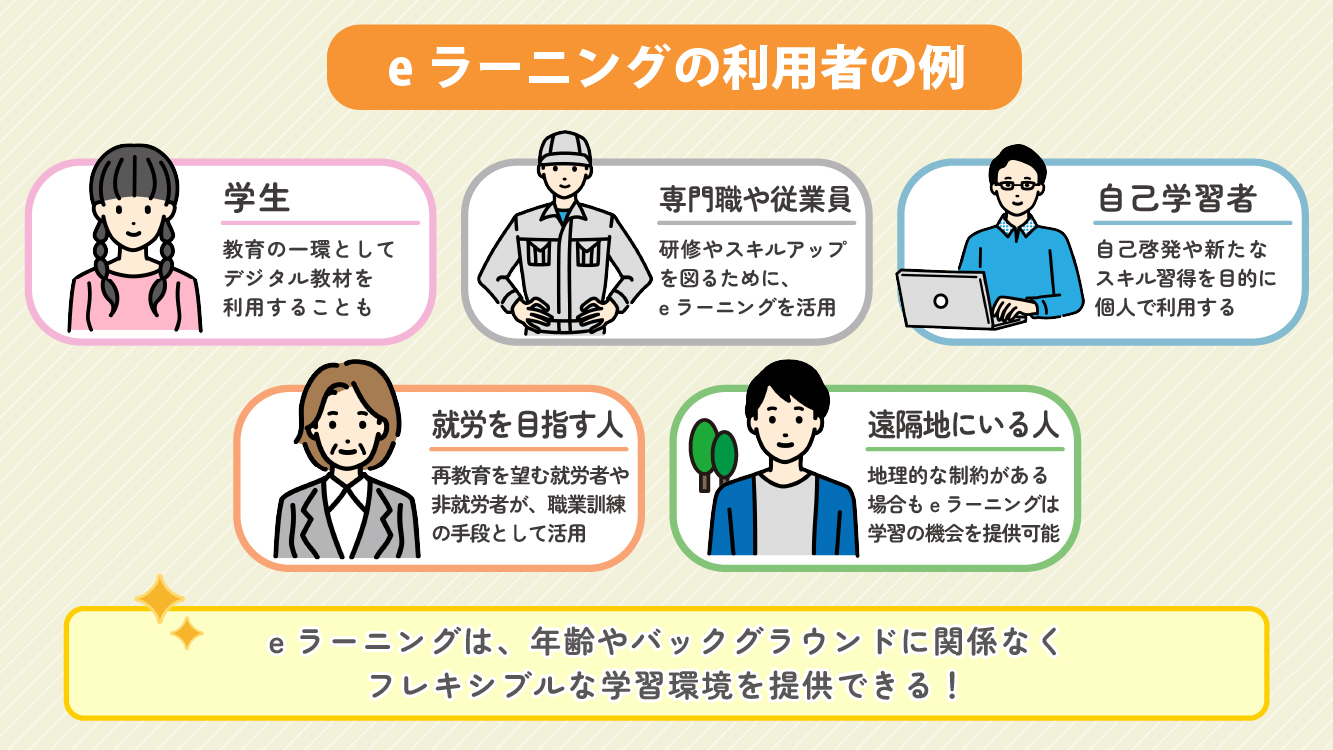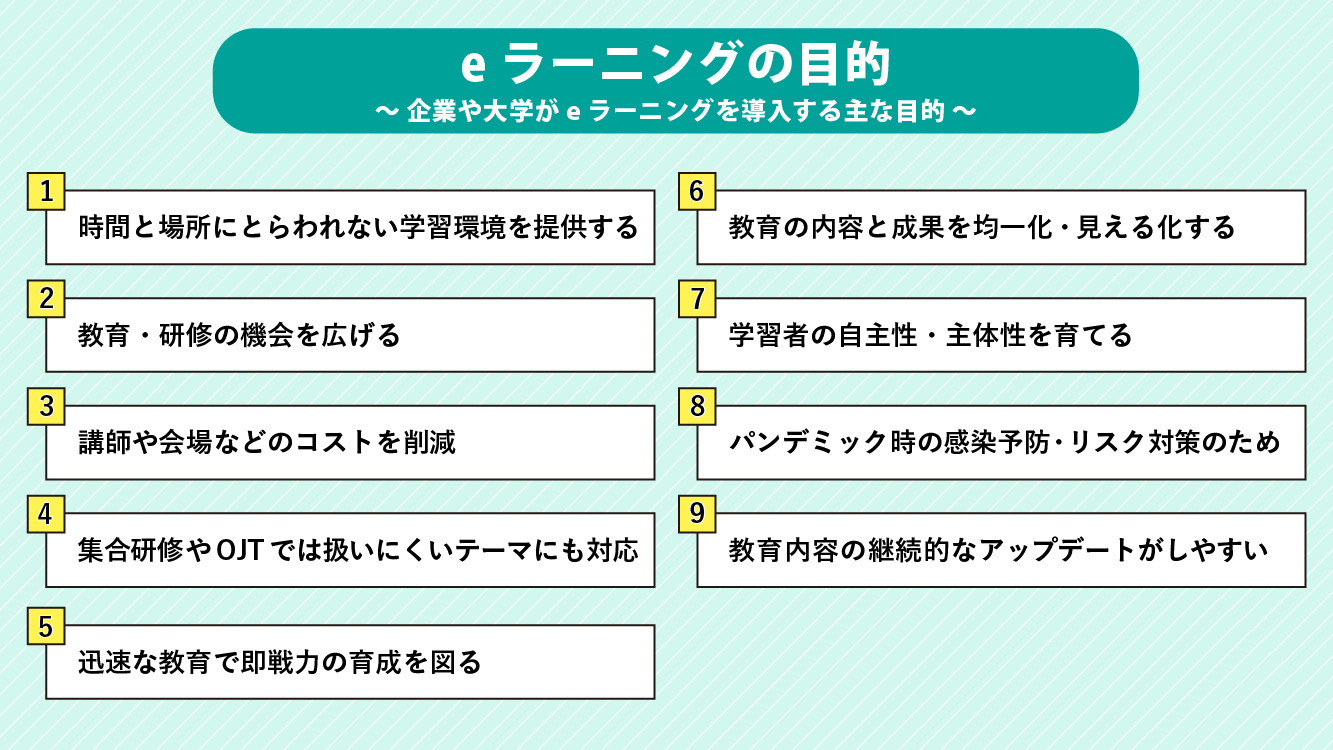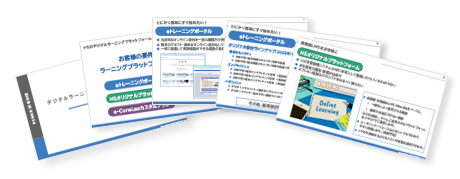2023.06.15
2025.06.27
What is e-learning? Explanation from purpose, history, advantages and disadvantages, usage, to key points for implementation!
E-learning, which can be accessed anytime and anywhere with devices such as smartphones and computers, is widely used by everyone from students to working professionals as a learning style that allows you to study at your own pace. This blog clearly explains everything from the basics of "What exactly is e-learning?" to its history, advantages and disadvantages, specific usage methods, and key points for implementation, making it easy to understand even for beginners.

Table of Contents
1. What is e-Learning?
2. Purpose of e-Learning
3. History of e-Learning
4. Latest Information on e-Learning
5. Advantages and Disadvantages of e-Learning
6. Specific Ways to Use e-Learning
7. Three Essentials for Introducing e-Learning
8. Taking the First Step to Start e-Learning Together (Summary)
1. What is e-learning?
E-learning refers to a form of learning that uses electronic devices such as computers, smartphones, and tablets to gain knowledge through the internet. The "e" stands for electric (electronic), and "learning" means learning.
E-learning typically involves the use of online courses and training programs. Learners can access content and study at their own pace, at times and places that are convenient for them. Unlike one-time workshops, it can be repeated multiple times for learning. Furthermore, e-learning can incorporate interactive elements, which offers the advantage of improving learning effectiveness, participation rates, and completion rates.
It is now being utilized in various fields such as school education and corporate training. Examples include online universities, vocational schools, and internal training programs of companies. Additionally, in recent years, the demand for e-learning that can be done at home has surged due to the outbreak of the novel coronavirus.
Examples of e-learning users

(1) Students
As part of school education or university education, online courses and digital materials may be utilized.
(2) Professionals and Employees
Companies and organizations are implementing e-learning to provide training and skill development opportunities for employees. Examples of educational programs include onboarding, product training, and security measures.
(3) Self-learners
There are cases where individuals utilize online courses and materials for self-improvement and acquiring new skills. The fields of study vary widely, including programming, design, languages, and marketing.
(4) Workers and Non-Workers Seeking Retraining
For those aiming for a career change or considering re-employment, e-learning serves as a means to acquire new skills and vocational training.
(5) People in Remote Areas
e-learning provides learning opportunities even for residents in remote areas with geographical constraints, such as those living in hard-to-access regions.
In this way, e-learning can provide a flexible learning environment for many people, regardless of age or background.
2. Purpose of e-Learning
Here, we introduce the main purposes for companies and universities to implement e-learning.

(1) Providing a learning environment free from constraints of time and place
The advantage of e-learning is that it allows learning anytime and anywhere as long as there is an internet connection. It can accommodate learners with diverse lifestyles and work arrangements.
(2) Expanding Opportunities for Education and Training
In face-to-face training, scheduling and traveling to the venue are required each time it is held, but with e-learning, this is not necessary. Therefore, it is possible to provide equal learning opportunities to those who have not had the chance to participate until now.
(3) Reduce costs such as instructors and venues
In group training, costs such as venue fees, transportation expenses, and instructor labor costs are incurred, but with e-learning, it is possible to significantly reduce these costs. It can truly be said to be a highly cost-effective educational tool.
(4) Also Suitable for Topics Difficult to Handle in Group Training or OJT
Topics such as harassment prevention, mental health, and personal information protection, which are difficult to address in front of large groups of learners, are well suited to e-learning. Since individuals take the course in their own environment, sensitive content can be studied calmly.
(5) Developing Immediate Workforce through Rapid Training
E-learning is also effective for quickly conveying the necessary knowledge and skills to new hires and mid-career recruits. For example, having them acquire basic knowledge before assignment leads to becoming an immediate asset in the field.
(6) Standardize and Visualize the Content and Outcomes of Education
E-learning ensures that all learners study using the same materials, eliminating variations in learning content. Additionally, there is no concern about differences in instructor quality or teaching methods. Furthermore, since learning progress and test results can be managed within the system, it is also possible to "visualize" learning outcomes.
(7) Fostering Learners' Autonomy and Initiative
Since learners progress according to their own schedules and level of understanding, it is also expected to cultivate learners' "motivation to learn" and "self-management skills."
(8) For Infection Prevention and Risk Measures During a Pandemic
The outbreak of the novel coronavirus has made it clear that face-to-face training carries risks. With e-learning, safe education can be achieved without contact or face-to-face interaction.
(9) Easy to Continuously Update Educational Content
E-learning makes it easy to update materials, so even when system revisions or operational changes occur, timely updates and immediate distribution are possible. It allows for providing education based on the most current information at all times.
In this way, e-learning is not just a "convenient learning method" but provides greater value. It can be utilized in various ways according to the objectives of each organization.
>Digital Learning - Considering the History and Future Trends of e-Learning
3. History of e-Learning

Currently established as one of the learning methods, e-learning actually dates back to before the widespread use of the internet. In this chapter, we will look back on the history of e-learning, exploring the path it has taken while also touching on the social and technological changes in the background.
<Before the 1990s> Research and Development of CAI
The roots of e-learning are considered to be "CAI (Computer-Assisted Instruction)," which emerged in the 1950s. CAI began with the idea of "using computers to support education," and research and development started around the world, mainly in the United States.
However, technology could not keep up with building an ideal system, and educational reform through CAI did not progress as expected. CAI saw significant development after the 1990s.
〈From the 1990s〉Establishment of CBT Education
In the 1990s, with the advancement of personal computers, CAI evolved into CBT (Computer-Based Training). CBT refers to a learning method that primarily uses CD-ROMs as teaching materials, offering content that combines various media such as text, images, audio, and video. In 1995, Windows 95, which gained explosive popularity, was released, and personal computers became widespread in general households. Education through CBT was established during this period.
〈Early to Mid-2000s〉WBT Penetration
The term e-learning began to be heard in Japan around the year 2000. With the government launching the "e-Japan Initiative (*)", attention was focused on converting traditional media such as paper into electronic formats.
Recently, with the generalization of the internet, e-learning has shifted from CBT to web-based learning. The method of online learning is called WBT (Web-Based Training). With educational materials now available online, learners can easily access them anytime and anywhere, whether at home or in the workplace.
With the spread of WBT, Learning Management Systems (LMS) have become widespread, enabling educational institutions and companies to efficiently manage online learning. It was also during this period (2001) that the Japan e-Learning Consortium, the predecessor of the Digital Learning Consortium, was established.
(*) A concept aimed at realizing the Japanese-style IT society advocated by the Japanese government
〈2010s and beyond〉Spread of Video Learning Materials and Penetration of Mobile Devices
With the spread of high-speed internet, video content has become an important element of e-learning. Lectures, explanations, and demonstrations are provided in video format through YouTube and dedicated learning platforms, enabling a more visual learning experience.
Furthermore, mobile devices such as smartphones and tablets have become more accessible, supporting the feature of e-learning that allows for "learning anytime, anywhere." As a result, a more flexible learning environment that allows learners to study at their own pace has been further developed.
〈Late 2010s to 2020s〉Utilization of AI Technology
With the advancement of artificial intelligence (AI) technology, "adaptive learning" has emerged, which analyzes learners' progress and tendencies to provide appropriate learning content. This enables "customized learning" tailored to individual learning styles.
In this way, e-learning has undergone significant evolution alongside technological innovation, bringing about revolutionary changes in the field of education. Thanks to the power of technology, learning environments tailored to individual learning styles are provided, allowing knowledge and skills to be acquired more effectively and efficiently.
4. Latest Information on e-Learning

Today, e-learning is widely prevalent, but it is said that e-learning became common in Japan around the year 2000. At that time, the spread and acceleration of the internet progressed, and online learning rapidly developed. Furthermore, in the mid-2000s, "Web 2.0" emerged, enabling interactive learning experiences. After that, mobile devices such as smartphones and tablets continued to appear, and e-learning is becoming increasingly widespread.
Moreover, due to advancements in technology such as the acceleration of the internet and the evolution of devices, e-learning itself is transforming from its traditional role of "knowledge transmission" to a tool that provides more effective "experiential learning" for knowledge retention.
So, what kind of learning experiences can we have with the current e-learning? We will provide you with the latest information on the evolving e-learning.
(1) Microlearning
A style of learning that takes about 1 to 5 minutes, allowing learners to efficiently study small topics at their own pace. It has the advantages of effectively utilizing spare time and maintaining concentration more easily.
(2) Utilization of AI (Artificial Intelligence)
By utilizing AI, we can provide customized optimal learning plans based on learners' progress, requests, and performance. Additionally, it is possible to analyze learning outcomes and improve the learning process based on that analysis.
(3) Collaboration with Educational Big Data
Educational big data refers to the large-scale collection and analysis of various education-related information, such as learners' progress, behavior, and assessment data. By utilizing this data, it is possible to provide unprecedentedly detailed and accurate evaluations, support, and educational improvement plans.
(4) Active Learning
Active learning, where participants can engage in learning actively, is different from traditional passive learning (a style of learning with content provided unilaterally) and is ideal for acquiring human skills such as "communication skills" and "negotiation techniques." There is an increasing variety of content, including online discussions and group work.
(5) VR (Virtual Reality) and AR (Augmented Reality)
Learning methods incorporating virtual reality (VR) and augmented reality (AR) are also gaining attention. By utilizing these technologies, scenes that are difficult to reproduce or experience, such as during disasters or in medical settings, can be realistically simulated, providing a more practical learning experience.
(6) Collaboration with Social Learning
Collaboration among learners and social learning are also effective for knowledge retention. Through online communities, discussion forums, and collaborative tools, learners can exchange information and opinions, and learn together while cooperating.
By combining such learning methods in a multifaceted way, we can provide optimal e-learning tailored to the needs of each learner, leading to the realization of the "best learning experience."
5. Advantages and Disadvantages of e-Learning

So far, we have explained what e-learning is, but what are the actual advantages and disadvantages? In this chapter, we will discuss the advantages and disadvantages of e-learning compared to face-to-face group training from both the learner's and the administrator's perspectives.
◎ Benefits for Learners
(1) Learning achievements are recorded
e-learning delivery and participation are generally managed by an LMS (Learning Management System), so individual learning histories and grades are typically recorded on servers, etc. The recorded data can be referenced by administrators at any time. Therefore, learners can receive objective evaluations.
(2) Learn at your own pace anytime, anywhere
Unlike scheduled group training with fixed dates and locations, e-learning allows you to study anytime and anywhere as long as you have a mobile device and an internet connection. The ability to learn freely at your own pace without constraints is a significant advantage. The ease of learning also contributes to the "habitualization of learning."
(3) Review as many times as you want
Classroom training is limited to that day, and it ends when the time is up. Even if you have the text in hand, the opportunity to be "taught" is only once. On the other hand, e-learning can be taken repeatedly, allowing for thorough repetition until you understand it completely.
● Disadvantages for Learners
(1) Maintaining Motivation is Difficult
Depending on individual characteristics, there are quite a few people who look forward to the "lively atmosphere of group training." In any case, on that day, they step away from their work and learn together with everyone. For those who use this contrast as motivation for training, it is expected that e-learning may feel insufficient and lead to a lack of motivation.
Unlike group training that can be attended with just oneself, e-learning requires an internet environment and a device. However, it is now common for companies to provide personal computers, and many companies allow the use of personal devices for e-learning attendance under certain conditions.
◎ Benefits for Administrators
(1) Provides uniform education to a large number of learners
In group training, the number of participants is limited per session. Additionally, even when using the same text, there can be variations in the "quality of education" depending on the instructor. With e-learning, the same educational content can be delivered regardless of the number of participants.
(2) Lower Cost Compared to Group Training
According to a calculation conducted by Autobacs Seven Co., Ltd., a pioneer in the introduction of e-learning, it was found that if the educational measures initiated by the company using e-learning were conducted through group training, the cost would be approximately four times higher than that of e-learning.
(3) Diverse Methods for Acquiring Teaching Materials
The methods for acquiring e-learning materials include: ① purchasing off-the-shelf products, ② custom ordering, ③ customizing off-the-shelf products, and ④ producing in-house (often referred to as in-house production). By combining these options, it becomes easier to achieve originality and pursue ideal educational strategies.
● Disadvantages for Administrators
(1) IT Literacy is Required
e-learning requires a certain level of IT literacy from both administrators and learners, as digital devices such as computers and smartphones are used. Additionally, since there may be cases where personal information of learners is needed, knowledge about privacy and personal information protection, as well as the establishment of security measures, is necessary.
6. Specific Ways to Use e-Learning

From here, we will introduce what can specifically be done in e-learning for both learners and administrators.
■ What learners can do with e-learning
E-learning offers various learning environments and content tailored to individual learning styles. Taking the open-source LMS (Learning Management System) "Moodle" as an example, it often provides a platform for interaction with administrators and instructors, including submitting reports and assignments, answering surveys, and asking questions. Additionally, there may be systems in place to facilitate interaction among learners. Through this kind of "interactive learning," learners can engage more actively and are expected to see improvements in their learning outcomes.
*For more information about Moodle, please refer to this page.
Specific Functions
・Viewing training/class materials
・Downloading training/class materials
・Attendance for training/classes
・Workshops
・Interaction in group/individual forums
・Questions
・Surveys
・Today's ToDo
・Report/Assignment submission
・Tests ・Private files… etc.
■ What Administrators Can Do with e-Learning
In the case of the already mentioned "Moodle", it has features for managing attendance and grades, as well as managing learners' learning progress, allowing administrators to easily grasp each individual's progress. Furthermore, by analyzing the data from progress management and generating reports, it can also be useful for learning plans, instruction, and course improvements. Additionally, alongside the registration of teaching materials, it is also easy to conduct tests, surveys, and report submissions.
Specific Functions
・Attendance Management
・Online Training / Classes
・Upload Training / Class Materials
・Grade Management
・Report / Assignment Management
・Report / Assignment Grading and Evaluation
・Conducting Tests
・Test Quality Analysis
・Progress Management Reports
・Completion Certificates
・Open Badges
・GDPR (General Data Protection Regulation in the EU)
・SSO (Single Sign-On: Seamless system access through authentication integration)
・MFA (Multi-Factor Authentication)
・Advice in Group / Individual Forums
・Feedback
Furthermore, if the LMS is based on open-source platforms like Moodle, it is also possible to add necessary features through plugin development. By freely customizing the features, we can create a more user-friendly and effective e-learning environment.
7. Three Essentials for Introducing e-Learning

By utilizing feature-rich e-learning, we have found that it is possible to provide a high-quality learning experience easily and efficiently. To implement such e-learning, the following three elements are necessary: ① e-learning system (LMS), ② teaching materials, ③ support system for learners.
Let’s explain these three elements in detail.
① e-Learning System (LMS)
When introducing e-learning, the foundation is the "LMS". This is an abbreviation for "Learning Management System", also known as a learning management system. Many LMSs have the various functions introduced in the previous chapter, allowing for the management of learner registration and progress, as well as the uploading and setting of learning content.
A representative LMS is "Moodle." Moodle is an open-source all-in-one learning platform that is widely used as a global standard LMS.
*For more information about Moodle, please refer to this page.
>Support for the introduction and operation of Human Science LMS
② Teaching Materials
After building the operational environment for e-learning using LMS, what is needed is the "content of learning." In other words, teaching materials. There are mainly three methods to prepare teaching materials.
How to Prepare Teaching Materials
・Use materials provided by the e-learning provider
・Request production from the e-learning provider to create original materials
・Produce in-house (receive support from the e-learning provider for in-house production)
In general, LMS complies with SCORM (Sharable Content Object Reference Model: a standard for e-learning). Therefore, the educational materials themselves need to comply with SCORM to function correctly on the LMS. If the educational materials are SCORM-compliant, there are advantages such as being able to use the same materials in the same way across different LMS.
* For more information about SCORM, please refer to this page.
To create SCORM-compliant educational materials, it is advisable to use e-learning content creation tools such as "iSpring Suite" or "Storyline." In particular, "iSpring Suite" is a plugin for PowerPoint, making it relatively easy to create learning content.
However, creating educational materials requires a certain level of knowledge, so it is common to request assistance from a technician with specialized knowledge. If you want to prepare educational materials, it is recommended to consult with an e-learning provider.
> Related Column: What is iSpring Suite? Features, Pricing, and Benefits of Implementation
>e-Learning Content Production
③Support System for Learners
A support system for learners is essential for the smooth operation of e-learning. In addition to solving technical issues and managing the smooth progress of learning, caring for learners is also important. E-learning is fundamentally an individual learning process. Therefore, it is possible for learners to feel isolated or lose motivation.
Therefore, having support staff such as learning advisors (people who provide total care for learning) and tutors (people who answer questions about the materials) can help resolve learners' concerns, leading to increased motivation and improved results.
8. Taking the First Step to Start e-Learning Together

E-learning, an innovative learning method born from the fusion of advancements in digital technology and the field of education. In the 2000s, the use of LMS expanded further and began to be utilized in various educational settings.
At the same time, Human Science has been involved in the creation of educational materials since the early days of e-learning in Japan, building a track record of over 20 years. We hope that the correct know-how based on this extensive experience will be useful for your business.
If you are interested in e-learning and want to get started, or if you are facing challenges such as "employee motivation is low" or "the effectiveness of training is not visible," please feel free to consult with us. We will propose the optimal plan for employee training that combines efficiency and effectiveness.
Understand the Features and Usage of iSpring Suite / iSpring Suite AI!Comprehensive iSpring Guide

This section introduces the overview and usage of the animation teaching material production tool "iSpring."
This book provides a complete understanding of iSpring. You will also have an image of the teaching material production after implementation.
【Contents】
- What is iSpring Suite / iSpring Suite AI
- How to create teaching materials using iSpring Suite / iSpring Suite AI
- Overview and utilization of iSpring Suite AI
- Features of iSpring Suite AI
- Specific Usage of iSpring Suite AI
- iSpring Suite AI Certified Resellers
- Introduction to Human Science














